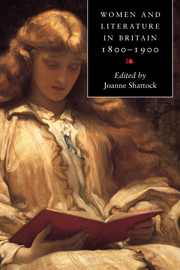Book contents
- Frontmatter
- Contents
- List of contributors
- Acknowledgments
- Chronology
- Introduction
- 1 The construction of the woman writer
- 2 Remaking the canon
- 3 Women and the consumption of print
- 4 Women writing woman: nineteenth-century representations of gender and sexuality
- 5 Feminism, journalism and public debate
- 6 Women's writing and the domestic sphere
- 7 Women, fiction and the marketplace
- 8 Women poets and the challenge of genre
- 9 Women and the theatre
- 10 Women writers and self-writing
- 11 The professionalization of women's writing: extending the canon
- 12 Women writers and religion
- 13 Women writing for children
- Guide to further reading
- Index
2 - Remaking the canon
Published online by Cambridge University Press: 03 October 2009
- Frontmatter
- Contents
- List of contributors
- Acknowledgments
- Chronology
- Introduction
- 1 The construction of the woman writer
- 2 Remaking the canon
- 3 Women and the consumption of print
- 4 Women writing woman: nineteenth-century representations of gender and sexuality
- 5 Feminism, journalism and public debate
- 6 Women's writing and the domestic sphere
- 7 Women, fiction and the marketplace
- 8 Women poets and the challenge of genre
- 9 Women and the theatre
- 10 Women writers and self-writing
- 11 The professionalization of women's writing: extending the canon
- 12 Women writers and religion
- 13 Women writing for children
- Guide to further reading
- Index
Summary
In January 1870, a respected British weekly, the Athenaeum, discussed several now-forgotten novels, and gave them short shrift. These included Lady Betty, by Christabel Coleridge, and Herbert Tresham, by the Revd J. M. Neale. Christabel Coleridge's novel is criticised mainly for its plot, which the anonymous reviewer finds badly constructed, tedious and implausible, while the Revd Neale's book is faulted both for being ‘pedantically written’, and for telling an ‘insignificant’ tale which the reviewer believes is ‘a mere pretext for thrusting the author's opinions down the reader's throat’. The review identifies no redeeming features in Herbert Tresham, but acknowledges that Lady Betty does contain ‘some pleasing writing’, and therefore suggests that Christabel Coleridge is ‘capable of something better’. What is notable, however, is that Lady Betty's faults are ascribed to the writer's sex, while this is not the case with the Revd Neale's novel. The review of Christabel Coleridge's text begins: ‘It scarcely needed the author's name affixed to the title page of “Lady Betty”, to tell us it was the work of a lady’ – and goes on to call the novel's story ‘feeble and badly designed’, as if this were the natural corollary of female authorship. By contrast, the pedantry and offensive didacticism of Herbert Tresham are not linked to the Revd Neale's sex, or even to his clerical status.
These reviews represent a minor instance of a practice endemic to nineteenth-century literary criticism – the ascription of particular characteristics to writing on the basis of its author's sex. Although this happened to texts by writers of both sexes, the practice was more common in discussions of women's publications.
- Type
- Chapter
- Information
- Women and Literature in Britain 1800–1900 , pp. 35 - 54Publisher: Cambridge University PressPrint publication year: 2001
- 2
- Cited by

